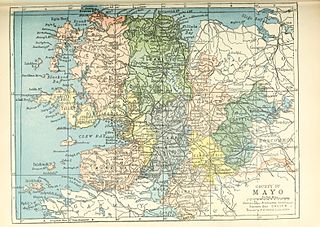
Connacht or Connaught, is one of the four provinces of Ireland, in the west of Ireland. Until the ninth century it consisted of several independent major Gaelic kingdoms.

Sir Richard Bingham was an English soldier and naval commander. He served under Queen Elizabeth I during the Tudor conquest of Ireland and was appointed governor of Connacht.

The Diocese of Killala is a Latin Church diocese of the Catholic Church in Connacht; the western province of Ireland. It is in the Metropolitan Province of Tuam and is subject to the Metropolitan Archdiocese of Tuam. As of 2024, the seat of the Diocese is “Sede Vacante” meaning there is no current permanent Bishop appointed for this Diocese
Philbin or McPhilbin are Irish surnames, which is a patronymic form meaning "family of Philip".

St Muredach's College is an all-boys secondary school on the banks of the River Moy in Ballina, County Mayo, Ireland. It was founded in 1906 to provide a Catholic education for boys in the Killala Diocese. The school building, which was designed by William Henry Byrne, is included on the Record of Protected Structures maintained by Mayo County Council.
Lady Agnes Campbell was a Scottish noblewoman and queen consort of Tír Eoghain. She was the mother of Iníon Dubh.
Sir Nicholas Malby (1530?–1584) was an English soldier active in Ireland, Lord President of Connaught from 1579 to 1581.

Tirawley, archaically known as Tyrawley, is a barony extending southward from the north coast of County Mayo, Ireland. It was created during the shiring of County Mayo out of the Gaelic túath or territory of Tír Amhlaidh, from which it takes its name.
James MacDonald, 6th Chief of Clan MacDonald of Dunnyveg, was a Scottish-Gaelic lord.
Tibbot MacWalter Kittagh Bourke was the 21st and final Mac William Íochtar and was created 1st Marquess of Mayo in Spanish nobility.

The history of the Bissett family in Ireland can be studied independently from that of the originally identical family in Scotland, because of their unique experience following their arrival in Ulster in the early or mid-13th century. Here, while still remaining involved in Scottish affairs, the Bissetts would establish themselves as the Lords of the Glens of Antrim and quickly become equally, then eventually more involved in the politics of the Irish province, becoming among the most Gaelicised of all the so-called Anglo-Norman families in Ireland. The heads of the leading branch of the family soon adopted the Gaelic lineage style Mac Eoin Bissett, by which they are known in the Irish annals, and which translates as "Son/Descendant of John Byset", after a prominent ancestor born in Scotland. In a number of English and Anglo-Norman sources the same head of the family is referred to as the Baron Bissett, also with variants.
The Uí Fiachrach were a royal dynasty who originated in, and whose descendants later ruled, the coicead or fifth of Connacht at different times from the mid-first millennium onwards. They claimed descent from Fiachrae, an older half-brother of Niall Noigiallach or Niall of the Nine Hostages. Fiachrae and his two full brothers, Brion and Ailill, were the collective ancestors of the Connachta dynasty that eventually became the new name of the province. Their mother was Mongfind.
Alexander Carragh MacDonald of Glenarm was a son of James MacDonald, 6th of Dunnyveg and Agnes Campbell, daughter of Colin Campbell, 3rd Earl of Argyll. Alexander, obtained possession of the barony of Glenarm. He was killed along with his brother, Donald Gorm, during the Battle of Ardnaree, Ireland in 1586 against the English.

St Muredach's Cathedral is the cathedral church of the Roman Catholic Diocese of Killala in Ireland. It is located on the east bank of the River Moy in Ballina, County Mayo. It is also the parish church of the parish of Kilmoremoy.
Events from the year 1586 in Ireland.
The Mayo Junior Football Championship is an annual Gaelic football competition contested by lower-tier Mayo GAA clubs.

Ballina is a town in north County Mayo, Ireland. It lies at the mouth of the River Moy near Killala Bay, in the Moy valley and Parish of Kilmoremoy, with the Ox Mountains to the east and the Nephin Beg mountains to the west. The town occupies two baronies; Tirawley on the west bank of the Moy River, and Tireragh, a barony within County Sligo, on its east banks. At the 2022 census, the population of Ballina was 10,556.
Tomás Óg Mág Samhradháin was chief of the McGovern Clan and Baron or Lord of Tullyhaw barony, County Cavan from 1584 until his death at the end of the 16th century.

The Dolmen of the Four Maols is a cist and National Monument located in County Mayo, Ireland.







